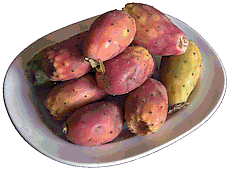- Subfamily Pereskioideae: broad leaves, no glochids.
Maihuenia, Pereskia
(or Maihuenia may be separated into Subfamily Maihuenioideae.)
- Subfamily Opuntioideae: fleshy round leaves present or absent, glochids present.
Austrocylindropuntia, Brasiliopuntia, Consolea, Corynopuntia, Cylindropuntia, Cumulopuntia, Grusonia, Maihueniopsis, Micropuntia, Opuntia, Pereskiopsis, Pterocactus, Quiabentia, Tacinga, Tephrocactus, Tunilla.
- Subfamily Cactoideae: no leaves*, no glochids. (incomplete list of genera)
Ariocarpus, Arrojadoa, Astrophytum, Aztekium, Blossfeldia, Calymmanthium, Carnegiea, Cereus, Cleistocactus, Copiapoa, Coryphantha, Echinocactus, Echinocereus, Echinomastus, Echinopsis, Epiphyllum, Epithelantha, Escobaria, Espostoa, Ferocactus, Geohintonia, Gymnocalycium, Hylocereus, Lepismium, Leuchtenbergia, Lobivia, Lophocereus, Lophophora, Maihueniopsis Mammillaria, Matucana, Melocactus, Neolloydia, Obregonia, Oreocereus, Pachycereus, Parodia, Pelecyphora, Pilosocereus, Pediocactus, Peniocereus, Rebutia, Rhipsalis, Sclerocactus, Schlumbergera, Selenicereus, Stenocactus, Stenocereus, Strombocactus, Thelocactus, Trichocereus, Turbinocarpus, Uebelmannia, Weingartia, Wilcoxia, Zygocactus and all other genera.
*Except that some species have seed leaves.
|
 Subfamily Opuntioideae Subfamily Opuntioideae
This sub-family includes over 300 species of cacti with the common characteristic of irritating barbed hairs (glochids) as well as ordinary spines. The seeds are hardened with a stone-like aril. Leaves where present are vestigial and short lived. Members of this subfamily range in size from mat-forming plants to shrubs and trees.
Native to a very wide range from central Canada to Patagonia in South America and naturalised in many warm climates where they may be regarded as invasive.
|

Brasiliopuntia (Willdenow) A. Berger 1926
Name: Opuntia from Brazil
A monotypic genus for the South-American succulent tree-like cactus Brasiliopuntia brasiliensis.
|
|
Brasiliopuntia brasiliensis (Willdenow) A. Berger 1926
A stout trunk growing up to 60 ft tall and patterned with areoles, supports rounded branching stems bearing flattened dark green cladodes. Areoles are furnished with glochids and 0 - 3 spines. The flowers are golden yellow and are followed by rounded spiny fruit containing up to 5 large seeds.
Native to Brazil, Paraguay, Eastern Bolivia, Peru and Northern Argentina and naturalised in other countries with tropical climates. The pulp inside the fruit is edible.
|
 Photos: RBG Kew Photos: RBG Kew
|
Consolea (Willdenow) A. Berger 1926
Named for: Michelangelo Console (1812 - 1897) Italian botanist at the Palermo Botanical Garden.
The genus includes 9 - 10 species of succulent tree-like cacti with rounded trunks and a crown of long flattened cladodes which have areoles with glochids and may or may not be spiny. The small flowers are yellow, orange or red.
Native to the Caribbean and Florida. They are vigorous growers and consequently used in dry landscaping. Chromosome analysis has shown that seven species are hexaploid (2n = 66) and two species octoploid (2n = 88).
|
|
Consolea falcata (Ekman & Werderman) F.M. Knuth 1935 (Caribbean Tree Cactus)
Syn. Opuntia falcata Ekman & Werdermann 1931
Name: Latin falcatus = sickle-shaped, referring to the shape of the stems.
This shrubby 8ft tall tree has flat shiny dark green cladodes up to 14 in long and furnished with spines. The small flowers are yellow fading to orange.
Native to Haiti and the Dominican Republic where it is considered endangered with a single population of only 10 - 12 individuals remaining. Noteworthy for posessing 88 chromosomes (octoploid).
|
Corynopuntia Knuth 1935 (Club Chollas, Perritos)
Name: Greek coryne = "club" + Opuntia
Many species that were in the genus Grusonia are now considered to be Corynopuntia. The genus Grusonia is currently monotypic for G. bradtiana.
Corynopuntia includes 16 species of Opuntiads with ovoid tuberculate segments, forming spiny cushions 2 - 10 in tall. The spines are strong with toothed margins and an epidermal sheath at the apex. Flowers are mostly yellow or pink to magenta in a few species. Fruits are fleshy when green but become dry and brownish, are covered in glochids and full of flattened yellowish seeds.
Native to the South-Western USA and Northern Mexico, generally growing in very dry areas at moderate elevations. Stem segments detach readily and can be transported for considerable distances stuck to fur or skin of animals by the toothed spines, rooting where they fall off.
|

Photo: RBG Kew.
Corynopuntia invicta (Brandegee) F.M.Knuth 1935 (Dagger Cholla)
Syn. Grusonia invicta (Brandegee) E.F.Anderson 1999
Name: Latin invicta = "unconquered"
This species has jointed, dark green stems formed from obovoid segments up to 5 in long, furnished with formidable spines which are bright red at first, fading to a pinkish-grey. The tubercles have large wooly areoles with a few white glochids, 6 - 10 radial spines and 10- 12 stout central spines. The stems eventually form a spiny mat 6 ft or more in diameter. Flowers are yellow.
Native to the Vizcaíno Desert of Central Baja California, Mexico.
|
 
Photos: Puerto Blanco Drive, Organ Pipe National Monument. Az.
Corynopuntia kunzei (Rose) Griffith 2003 (Kunze Club Cholla, Devil Cholla)
Syn. Grusonia kunzei (Rose) Pinkavai 1999
Opuntia stanlyi var kunzei (Rose) L.D. Benson 1944
Named for: Lord Edward Smith-Stanley, 13th Earl of Derby (1775 - 1851) art collector & naturalist.
Richard Ernest Kunze (1838 - 1919) German physician, studied pharmacology of cacti.
The erect clavate stems are furnished with areoles bearing 17 - 27 stout flattened spines whose tips are sheaved.
Flowers are yellow and are followed by yellow fruits containing flattened brown seeds.
This low-growing Cholla tolerates salty ground on which little else will grow except creosote bushes.
Native to California and Arizona, Baja California and Sonora, Mexico where it widespread.
|

Photo: Big Bend National Park, Tx.
Corynopuntia schottii (Engelmann) FM Knuth in Backeburg & FM Knuth 1936 (Big Bend Prickly Pear, Devil Cholla, Dog Cholla, Clavellina)
Syn. Grusonia schottii (Engelmann) HE Robinson 1973
Opuntia schottii Engelmann 1856
Named for: Arthur Carl Victor Schott (1814 - 1875) botanist & cartographer along the Texas border.
The cylindrical jointed tuberculate stems are furnished with areoles bearing 8 - 14 spines with a single stout main central spine.
Flowers are yellow and are followed by spiny yellow fruits.
Native to the Rio Grand Valley and Big Bend country of Texas into the Mexican States of Chihuahua and Durango, forming big mats on stony ground, generally on clay soils not limestone. Dead joints detach and blow in the wind. Their spines go straight through the sole of a hiking boot or attach to one's ankles.
|
Cumulopuntia F. Ritter 1980
Name: Latin cumulo = pile or heap, referring to growth as mounds of stem segments.
The genus has been applied to as many as 30 species but currently includes around 4 species whose jointed stems form compact cushions. The fruits contain no pulp and the seeds differ from those of other Opuntias.
Native to high deserts of South America where they experience dry cold and prolonged droughts. In cultivation Cumulopuntias tend to suffer from heat and do not receive the intense UV-rich light of their native habitat, so are prone to elongated growth and to develop few or weak spines.
|
 
Photo: RBG Kew
Cumulopuntia boliviana (Salm-Dyck) F. Ritter 1980 (Copana)
Name: from Bolivia.
This species forms low mats or cushions of jointed stems with short ovoid tuberculate segments. Tubercles are furnished with glochids and those near to the ends of stems produce long golden spines, more so in habitat than in cultivation. Relatively large, bright yellow flowers are produced at the stem tips.
Native to sandy soils of South American high deserts including Argentina, Bolivia, Chile & Peru at altitudes of 6000 ft to over 14,000 ft above sea level.
|
Cylindropuntia (Engelmann) Knuth 1754 (Cholla)
Name: = cylindrical Opuntia referring to the stems
The 35 species of cacti in Cylindropuntia were formerly included in Opuntia but were separated on the basis of cylindrical stem segents and papery sheaths on their barbed spines. Cylindropuntia species range from small sub-shrubs to large trees. The stems of some species have a characteristic woven or rope-like appearance.
Chollas are native to the South-Western USA, Northern Mexico and the West Indies. Large stands of genetically homogenous chollas occur in some places, where plants propagate vegetatively from dehiscent stem segments.
|
 
Photo: near Why, Az.
Cylindropuntia arbuscula (Engelmann) F.M.Knuth 1935 (Arizona Pencil Cholla)
Opuntia arbuscula Engelmann 1856
A shrubby Cholla occasionally growing 9ft tall, but usually much less. The rounded to angular succulent stems have widely spaced areoles with just one or two long yellowish spines per areole. The small flowers are greenish-yellow to orange-yellow and are followed by green club-shaped fruits. This cactus is hexaploid (2n=66).
Native to the Sonoran Desert from central Arizona into Sonora, Mexico.
|
|
Cylindropuntia bigelovii (Engelmann) F.M. Knuth 1935 (Teddy Bear Cholla, Jumping Cholla)
Syn. Opuntia bigelovii Engelmann 1856
Named for: John Milton Bigelow (1804 - 1878) American surgeon & botanist
This cactus makes a large bush or small tree, occasionally up to 10ft tall. A stout trunk supports a cluster of segmented branches covered with an impenetrable array of yellow spines 1 inch long that completely obscure the stem and provide a fuzzy appearance. The cylindrical segments detach easily, especially those that the ends of branches, and root where they fall or attach themselves to passing animals and people to distribute themselves. Areoles produce 8 - 10 spines covered in a papery sheaf and barbed as well as 4 mm glochids and some wool.
|
| Photo above: A forest of Cylindropuntia bigelovii. Cactus garden, Joshua Tree Park, California. |



Photos above: Cylindropuntia echinocarpa Death Valley National Park, Ca.
Cylindropuntia echinocarpa (Engelmann & J.M. Bigelow) F.M. Knuth 1935 (Golden Cholla, Silver Cholla, Wiggins' Cholla)
Syn. Opuntia echinocarpa Engelmann & Bigelow 1857, Opuntia wigginsii L.D. Benson 1969
Named for: Ira Loren Wiggins (1899-1987) botanist at Stanford University
This large Cholla grows up to 7ft tall and may spread as wide. The stem is formed from cylindrical green segments covered with fleshy tubercles which each bear up to 20 long spines. Spination varies in colour from silver to golden. Flowers are greenish yellow to brownish or pink and are followed by spiny inedible fruit with white seeds.
Native to dry deserts of Arizona, California, Nevada, Utah and North-Western Mexico including the Sonoran, Mojave and Colorado Deserts. Green-flowered Opuntia wigginsii may be a natural hybrid between Cylindropuntia ramosissima (Pencil Cholla) and C. echinocarpa.
|
 
Big Bend National Park, Tx. 1990
Cylindropuntia imbricata (Haworth) de Candolle 1828 (Tree Cholla, Cane Cholla, Devil's Rope Cactus)
Name: L. imbricata = overlapping referring to the ridges on the stems
This large shrubby Cholla grows up to 15ft tall and may spread as wide. A stout trunk supports branching stems formed from cylindrical green segments covered with long fleshy tubercles giving an appearance of woven rope. Stem segments are furnished with areoles bearing clusters of 8 - 15 long (1 inch) pinkish barbed spines with white to brown sheaths, and numerous smaller glochids that embed themselves in the skin.
Flowers are usually magenta with the sheen of silk and are followed by spiny inedible yellowish fruit with a hollow end where the flowers detached. Variants with white or pale pink flowers occur occasionally. Asexual reproduction also occurs by stem joints falling off and rooting, or attaching to the skin of animals and falling off at a distance from the parent plant.
Native to moderate altitudes of 3,900 to 7,500 ft in dry deserts of Texas, Nevada, Arizona, New Mexico, Colorado, Oklahoma, Texas and into Northern Mexico. In places it may be the most prominent plant in a landscape or may grow in thickets. It has become an invasive weed in Australia and also occurs around the Mediterranean and in South Africa. It is relatively hardy in dry conditions but unlikely to tolerate wet cold. A number of desert animals including pronghorn, desert bighorn sheep, deer and some cattle eat the dry fruits despite the spines, thus helping to distribute the seeds.
|

Photo: small specimen on stony ground 20 miles North of Las Vegas.
Cylindropuntia ramosissima (Engelmann) F.M. Knuth 1935 (Branching Pencil Cholla, Diamond Cholla)
Syn. Opuntia ramosissima Engelmann 1852
This shrubby cactus can grow 6ft tall, but more usually less. The narrow cylindrical grey-green stems are patterned with flattened diamond-shaped tubercles. Most tubercles have minute barbed glochids and no spines, but every so often there is an occasional single long straight spine. The small flowers are orange to brownish.
Native to a wide range across the Mojave and Sonoran deserts of California, Arizona, Nevada, Northwestern Mexico, Baja California and Islas San Benito.
|

Photo: seedling, RBG Kew.
Cylindropuntia whipplei (Engelmann & J.M.Bigelow) F.M. Knuth 1935 (Whipple's Cholla)
Syn. Opuntia whipplei Engelmann & J. M. Bigelow 1856
Named for: Amiel Weeks Whipple (1818 - 1863) U.S. Army surveyor & botanist
This cactus makes a sturdy 4 - 5 ft spiny shrub with many cylindrical branches covered in oval tuberculate projections. Areoles produce 7 to 14 spines with one long 2 in spine in each group. Green flowers are produced at the ends of the branches in the Spring, followed by cylindrical yellowish green fruits with tubercles but no spines.
Native to Arizona, Colorado, New Mexico and Utah. Grows in impenetrable thickets.
|
 Maihueniopsis Spegazzini 1925 Maihueniopsis Spegazzini 1925
Name: Maihuenia + Greek opsis = view, referring to resemblance to Maihuenia
The genus Maihueniopsis contains 18 - 19 species of cactus, unrelated to Maihuenia. Several species have tuberous roots or taproots. They form low cushions of segmented rounded stems with vestigial leaves that are soon lost. The spination varies from long and lethally sharp to tiny spines held tightly against the plant body. The flowers are mostly shades of yellow, but also red and white.
Native to a wide range across Peru, Chile, Argentina and Bolivia, often at high elevations of 13,000 ft above sea level where frost and snow are experienced together with strong light and ultraviolet.
The genus Puna has been merged into Maihueniopsis.
|

Photo: Holly Gate Cactus Nursery reference collection.
Maihueniopsis bolivianum (Salm-Dyck) R. Kiesling 1984
Syn. Cumulopuntia boliviana subs. dactylifera (Vaupel) D.R.Hunt 2002
Syn. Opuntia dactylifera Vaupel 1913
Syn.
This plant forms dense cushions of segmented ovoid stems with areoles producing 0 - 7 spines. Flowers are yellow followed by spineless ovoid green fruits.
Native to Bolivia and Peru at high altitudes around 12,000 ft above sea level. In cultivation this species likes cool growing conditions.
|

Photo: RBG Kew
Maihueniopsis darwinii (Henslow) F. Ritter 1980
Opuntia darwinii Henslow 1837
Named for: Charles Darwin (1809 - 1882) author of "On the Origin of Species"
This mat-forming cactus has olive-green cladodes with large areoles bearing stiff, lethally-sharp spines with a raised central rib and flattened margins. Flowers are orange-yellow followed by fleshy fruit of similar appearance to the cladodes. Roots are tuberous and sensitive to over-watering.
Native to Argentina and Chile. Tolerates light frost and snow in its habitat.
|

Photo: Holly Gate Cactus Nursery reference collection
Maihueniopsis minuta (Backeberg) R. Kiesling 1984
Tephrocactus mandragora Backeberg 1953
Name: Latin minuta = tiny
This mat-forming cactus has small, branching, ovoid to conical stem segments up to an inch long. Areoles are sunk into the stem and produce glochids and a few spines recurved against the plant body, or spines may be absent. The relatively large flowers are yellow and followed by fleshy fruits.
Native to a limited range in Northern Argentina. In its habitat, the plant is often partially buried in the ground.
|
|
Maihueniopsis nigrispina (Schumann) R. Kiesling 1984
Syn. Tephrocactus nigrispinus (K. Schumann) Backeberg 1935
Syn. Opuntia nigrispinus K Schumann 1898
Name: Latin nigrispina = with black spines
This low, shrubby cactus has branching ovoid to cylindrical purplish-green stem segments, with wooly areoles bearing 3 - 5 long spines on newer growth. The black spines fade to gray as the cladode matures. Flowers and fruit are red.
Native to Argentina and Bolivia, growing at altitudes of up to 12,500 ft above sea level.
|
 Opuntia (Linnaeus) P. Miller 1754 (Prickly Pear, Nopales [pads], Tuna [fruit]) Opuntia (Linnaeus) P. Miller 1754 (Prickly Pear, Nopales [pads], Tuna [fruit])
Named for: Opus "a town of Locris in Greece". Theophrastus (371-287 BC) mentioned an edible plant growing there that was propagated by leaf cuttings. However, this could not have been an Opuntia as the genus originates from the Americas, unknown in that era.
 The genus Opuntia is a large group of cacti with flattened paddle-shaped stem segments (cladodes) furnished with two sorts of spines: large fixed spines and small, hairlike spines (glochids) that easily detach from the plant and penetrate the skin causing irritation.
The genus Opuntia is a large group of cacti with flattened paddle-shaped stem segments (cladodes) furnished with two sorts of spines: large fixed spines and small, hairlike spines (glochids) that easily detach from the plant and penetrate the skin causing irritation.
Native to a wide range of the Americas from British Columbia and Canada to Patagonia, South America, the West Indies and the Galapagos Islands. Opuntias have been introduced to many countries with mild climates and are considered invasive in some. Some species of Opuntia are cultivated for their fruit which tends to be full of large hard seeds.
|
 Photo: Death Valley California.
Opuntia basilaris Engelmann & J.M. Bigelow, 1857 (Beavertail Cactus)
Name: Latin basilis = basal + aris = 'from the base'
This is a low-growing (2 ft) cactus with gray-green to purplish pads that can wrinkle in drought. The areoles have white or brown wool and brown glochids with occasional spines on new pads. Flowers are bright pink.
Native to Arizona, California and Nevada and into North-Western Mexico, growing at up to 3000 ft above sea level.
|

Photo: near Marathon, Texas.
Opuntia engelmannii Salm-Dyck ex Engelmann 1850 (Engelmann's Prickly Pear)
Named for: Botanist George Engelmann (1809 - 1884) described flora of Western North America
A commom shrubby plant up to 11ft tall consisting of large 6 - 12 in long ovate pads joined end to end. The pads are furnished with areoles bearing yellowish glochids that age to brown and 1 - 8 white to yellow spines per areole. Flowers are yellow, sometimes reddish and each lasts for just 8 hours. They are folowed by purple edible fruit that were prized by American Indians.
Widely distributed from California to Louisiana and across the border into the Chihuahuan and Sonoran deserts of Mexico.
This species has many varieties and hence synonyms. It often hybridises with Opuntia phaeacantha.
|
|
Opuntia echios J.T. Howell 1933 var barringtonensis E.Y Dawson 1962
Name: Greek echios = hairy snake head
barringtonensis - from Barrington Island, named after Admiral Samuel Barrington.
This tree-sized Opuntia grows up to 30ft tall with large 10 - 18 inch long ovate stem segments patterned with a regular array of areoles. There are few glochids but areoles have 2 - 20 yellow-brown spines. The large (5 in) flowers are yellow and followed by green to grownish fruit. Mature specimens have an orange-brown main stem with flaking bark.
Native to the Galápagos Islands with five quite dissimilar varieties differently distributed across the islands. The large-growing variety shown is endemic to Santa Fe (Barrington Island). Opuntia echios var echios is more shrubby.
|
 |
Opuntia erinacea var. hystricina (Engelmann & J.M. Bigelow) L.D. Benson 1940
Photo: near Salt Flats, Texas.
|
|
Opuntia humifusa (Rafinesque) Rafinesque 1830 (Devil's Tongue, Eastern Prickly Pear)
Syn. Opuntia compressa var. humifusa J.F. Macbride 1922
Name: Greek - humus = soil + fusus = spread, extended
Shrubby plants consisting of one or two large flattened pads joined end to end with each areole bearing a vestigial leaf and glochids. There are a one or few spines on areoles near to the edges of pads but spines may be completely absent. Flowers are pale yellow folowed by edible reddish fruit. Selected clones may have red centres.
Widely distributed across Eastern USA, including dry areas of Montana to New Mexico and East towards the coast and islands. Plants may form large colonies as pad drop off and re-root.
Photo: limestone escarpment, Langtry, Texas.
|

Chelsea Flower Show 2019
Opuntia lanceolata (Haworth) Haworth 1812
Opuntia maxima Miller 1768
Left: Opuntia lanceolata cristate
Reversion to normal growth can be seen at the rear of the clump.
|
|
Opuntia lasiacantha Pfeiffer 1837 (Nopal de Cerro)
Name: Latin lasiacantha = wooly, prickly
This shrubby Opuntia has eliptical stem sections with areoles furnished with glochids and 1 - 3 small spines. Flowers are yellow to orange followed by reddish, spiny, conical, edible fruit.
Widely distributed in the Mexican states of Aguascalientes, Chiapas, Guanajuato, Guerrero, Hidalgo, Jalisco, México Distrito Federal, México State, Michoacán, Nuevo León, Oaxaca, Puebla, Querétaro, San Luis Potosí, Tamaulipas, Tlaxcala and Zacatecas, where it is used as food for animals and people.
|
 
Photos: Big Bend National Park, Tx.
Opuntia macrocentra var. violacea (Engelmann) L.D.Benson 1969 (Purple Opuntia)
Syn. Opuntia macrocentra Engelmann 1856, Opuntia violacea Engelmann 1848.
Name: Greek macrocentra = long spines + Latin violacea = purple
A shrubby cactus growing 2 - 3 ft tall with stems formed from flattened large blue-green pads joined end to end. The pads take on a purple hue at their edges and especially when stressed. The arealoes on the pads have many glochids and a few long black spines which make Opuntia macrocentra easily recognised. Flowers are yellow, usually with a red throat.
Widely distributed across West Texas, New Mexico, Arizona and Northern Mexico.
|


Photos: RBG Kew
Opuntia quitensis F.A.C. Weber 1898 (Red Buttons Opuntia)
Syn. Opuntia johnsonii Hort.
Named for: Quito, capital city of Ecuador
This shrubby cactus grows to 5 ft tall with both prostrate and upright branches. Areoles produce glochids, a few weak or strong gray spines or no spines and on new growth, stubby vestigial leaves which are soon lost. The orange flowers are dioecious, usually one at the end of each stem. Stamens in the female flowers do not produce pollen.
Native to Ecuador and Peru growing at low elevations in valleys and plains.
|
 Pterocactus Schumann 1897 Pterocactus Schumann 1897
Name: Greek pteron = wing, referring to the winged seeds.
The genus Pterocactus includes 9 species with spheroidal to elongated stem segments bearing areoles with glochids but few or minimal spines except in a few species. A single flower is produced from the end of new stems, followed by dry dehiscent fruit containing broad, papery winged seeds. Roots are tuberous and allow the plant to survive loss of its stems during Winter.
Native to the Patagonia region of Argentina.
|
|
Pterocactus tuberosus (Pfeiffer) Britton & Rose 1919
Name: Latin tuber = truffle, referring to the thick roots.
Syn. Pterocactus kuntzei Schumann 1897
Named for: Dr. Carl Ernst Otto Kuntze (1843 - 1907) German botanist.
This geophyte develops a huge tuber supporting thin, cylindrical, brownish-purple stems that break off easily, especially during Winter. The dehiscent stems blow in the wind and may root to form a new plant. The tuber produces new stems in the Spring. Pale yellow flowers are produced at the ends of new stems.
Native to Northern Argentina and Patagonia, growing in sandy soils with most of the tuber buried. In cultivation, the mature tuber may be raised above the soil for display but will not then grow any larger. As with many tuberous plants, this cactus is quite sensitive to overwatering and should be kept dry during the Winter.
|
 Quiabentia Britton & Rose 1923 Quiabentia Britton & Rose 1923
Name: from Quiabento a Brazillian native name for the plant.
The genus Quiabentia includes two species of tree-like cactus with a spiny trunk growing up to 50ft tall, branching to form a leafy crown above the reach of herbivores. Quiabentia is related to Pereskiopsis and has glochids in its areoles. The persistent, flattened fleshy leaves are unique to this genus of Opuntiads. Pink to red flowers with spiny floral tubes arise from the stem tips. Flowers are followed by rounded fleshy edible fruit with large rounded seeds.
Quiabentia verticillata is native to Argentina, Bolivia, and Paraguay. Quiabentia zehntneri is native to tropical dry forests of Bahia, Brazil. Uncommon in cultivation.
|

Photo: RBG Kew |
Quiabentia verticillata (Vaupel) Borg 1937
Syn. Pereskia verticillata Vaupel 1923
Name: Latin verticillatus = whorled, referring to branches arranged in whorls.
This tree-like cactus grows up to 50ft tall with spiny trunk and stems furnished with large, flattened oval to lanceolate succulent leaves. Flowers are pink to red followed by rounded fruit containing large, oblong seeds with a white aril.
Native to Argentina, Bolivia and Paraguay.
|
 Tephrocactus Tephrocactus
Name: Greek tephra = ash, referring to the colour of the plant bodies
The genus Tephrocactus includes 5 species of small Opuntiads, with many synonyms. The stems grow in distinctive rounded segments bearing areoles whose glochids are sunk into them and spines which may be long and sharp or papery or more or less absent. Flowers are usually white to pink, or yellow. Tephrocactus rossianus has red flowers.
Native to high elevations in the Argentinan Andes where they experience freezing conditions.
|
 |
Tephrocactus articulatus (Pfeiffer) Backeberg 1953
Syn. Tephrocactus articulatus var. strobiliformis A. Berger
Syn. Opuntia strobiliformis A. Berger 1929
The gray-green plant body is essentially spineless. Flowers are white.
Native to Western Argentina.
|

Photo: RBG Kew |

Photo: Farmer Matt 2015 |
Tephrocactus articulatus var. papyracanthus (Philippi) Backeberg 1953
A form of T. articulatus with a well-jointed grey-green body offset by white papery spines with glochids at their base.
Native to Argentina.
|

 |
Tephrocactus weberii (Spegazzini) Backeberg 1936
Named for: Professor Georg Heinrich Weber (1752 - 1828) German doctor and botanist at the University of Kiel.
This small shrubby cactus has branching, spiny cylindrical stems that form large cushions up to 8 in in height. Stem segments detach easily. The areoles have glochids and 3 - 10 long, flexible white to brown or black spines. Flowers are lemon to orange.
Native to central and Northern Argentina.
|
 Tunilla Hunt & Iliff 2000 (Airampo) Tunilla Hunt & Iliff 2000 (Airampo)
Syn. Airampoa Frič 1929
Name: Tunilla = small tuna, a common Spanish word for Opuntia pads.
The genus Tunilla includes 9 species of low-growing, mat-forming cacti with flat, jointed cladodes or rounded stem segments. The areoles produce both glochids and needle-like spines. Flowers are yellow to red. Fruits are dehiscent with a single slit, containing many kidney-shaped seeds and red pulp compacted together.
Native to Argentina, Bolivia, Chile, and Peru. Uncommon in cultivation.
|

Photo: RBG Kew
Tunilla corrugata (Salm-Dyck) D.R. Hunt & J. Iliff
Syn. Airampoa corrugata Frič 1929, Opuntia corrugata Salm-Dyck 1834
A mat-forming cactus with ovate, flattened segments to the jointed stems. Flowers are reddish with a green stigma.
Native to North-Western Argentina.
|

Photo: Holly Gate Cactus Nursery reference collection.
Opuntia sp.
Labelled as O. microsphaericus but that doesn't seem to be a valid name.
Might be a Tunilla sp.
|






























































